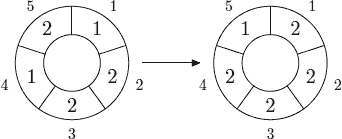A cellular automaton is a collection of cells on a grid of specified shape that evolves through a number of discrete time steps according to a set of rules that describe the new state of a cell based on the states of neighboring cells. The order of the cellular automaton is the number of cells it contains. Cells of the automaton of ordern are numbered from 1 to n.
The order of the cell is the number of different values it may contain. Usually, values of a cell of order m are considered to be integer numbers from 0 to m − 1.
One of the most fundamental properties of a cellular automaton is the type of grid on which it is computed. In this problem we examine the special kind of cellular automaton — circular cellular automaton of order n with cells of order m. We will denote such kind of cellular automaton as n,m-automaton.
A distance between cells i and j in n,m-automaton is defined as min(|i − j|, n − |i − j|). A d-environment of a cell is the set of cells at a distance not greater than d.
On each d-step values of all cells are simultaneously replaced by new values. The new value of cell i after d-step is computed as a sum of values of cells belonging to the d-enviroment of the cell i modulo m.
The following picture shows 1-step of the 5,3-automaton.

The first line of the input file contains four integer numbers n, m, d, and k (1 ≤ n ≤ 500, 1 ≤ m ≤ 1 000 000, 0 ≤ d < n⁄2 , 1 ≤ k ≤ 10 000 000). The second line contains n integer numbers from 0 to m − 1 — initial values of the automaton’s cells.
Output the values of the n,m-automaton’s cells after k d-steps.

1 /* 2 矩阵乘法 3 原理: 4 它的原理就是 5 a0 a1 a2 a3 a4 6 -> 7 (a4+a0+a1) (a0+a1+a2) (a1+a2+a3) (a2+a3+a4) (a3+a4+a0) 8 */ 9 #include<iostream> 10 #include<cstdio> 11 using namespace std; 12 int n,m,d,k; 13 void mul(long long a[],long long b[]) 14 { 15 int i,j; 16 long long c[501]; 17 for(i=0;i<n;++i)for(c[i]=j=0;j<n;++j)c[i]+=a[j]*b[i>=j?(i-j):(n+i-j)]; 18 for(i=0;i<n;b[i]=c[i++]%m); 19 } 20 long long init[501],tmp[501]; 21 int main() 22 { 23 int i,j; 24 scanf("%d%d%d%d",&n,&m,&d,&k); 25 for(i=0;i<n;++i)scanf("%I64d",&init[i]); 26 for(tmp[0]=i=1;i<=d;++i)tmp[i]=tmp[n-i]=1;//n*n的矩阵初始化 27 while(k)//二分求解 28 { 29 if(k&1)mul(tmp,init); 30 mul(tmp,tmp); 31 k>>=1; 32 } 33 for(i=0;i<n;++i)if(i)printf(" %I64d",init[i]);else printf("%I64d",init[i]); 34 printf(" "); 35 return 0; 36 }
